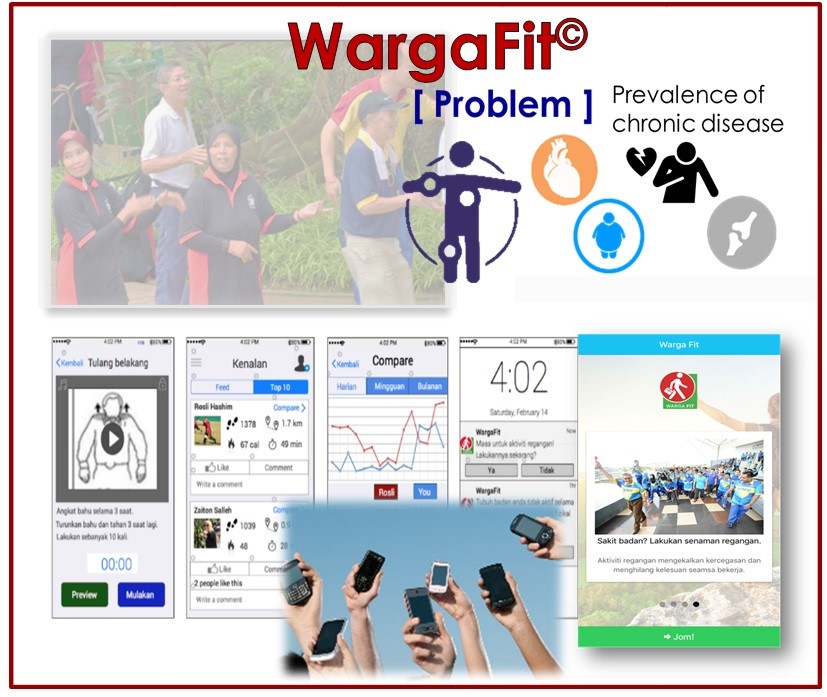Development of a Smart Personalized Digital Educational Package for the Elderly Based on PET (Persuasion, Emotion, Trust) Design Approach 06-01-02-SF1083 ESCIENCEFUND
– Headed by Assoc. Prof. Dr. Nazlena Mohamad Ali.
Copyright and Trademark certification: WARGAFIT LY2017004606, 2017.
INTRODUCTION OF RESEARCH
Regular physical activity has proven effective in preventing the development of chronic diseases, which are highly prevalent among workers aged 50 years and above. However, encouraging physical activity behaviour among the population is challenging due to prolong hours of sedentary behaviour at the workplace. Persuasive Technology could be utilised to enhance the physical activity of older workers. Persuasive Technology refers to computing systems designed to change attitude or behaviour without using coercion or deception. In order to assist designers in designing persuasive application, Persuasive System Design (PSD), a framework that described process of designing and evaluating a persuasive system had been introduced. The framework also enlisted persuasive design principles that were classified into four categories; primary task support, dialogue support, system credibility support and social support. This thesis presents the process of designing and evaluating a persuasive application aiming to enhance physical activity at the workplace among older workers based on the PSD approach. The objective is to determine which persuasive design principles are effective at encouraging physical activity at the workplace among older workers. Our work began by investigating the barriers and motivating factors influencing older workers’ physical activity behaviour. Then, we determine persuasive principles that are relevant to manipulate those factors using expert consensus approach. In order to understand end-user perceptions towards these persuasive principles, a prototype called WARGAFIT© was built. In summary we consider, 1) the lack of detailed guidelines on the process involved in the design of persuasive application; and 2) identification of persuasive principles that is most effective to encourage physical activity among older workers; as the research gap that requires further investigations.
FINDINGS OF RESEARCH
We identified several design requirements: –
Contextual Awareness – One of the persuasive design elements of the app is reminder i.e. whenever the app did not detect any physical movement for hours, a reminder would be set to encourage user to walk or perform stretching at their workstation.
Visibility of cause-and-effect relationship – The significance of highlighting this cause-and-effect relationship between physical activity and its associated health-related outcome had been emphasized in several studies. Thus, by properly visualizing how physical activity would improve older workers’ health status (e.g. by providing information on calories burnt for each steps) would potentially increase their motivation to do physical activity, leading to a more active and healthy lifestyle.
Accuracy and reliability of the data presented – Although the detailed reports of physical activity performance are imperative (e.g. steps count, calories burnt, and active minutes), the effectiveness of this feature is largely depends on the capability of the application at providing accurate and reliable data.
Information sharing and privacy control – The app also was integrated with competition and social comparison features where users able to compare their performance with their colleagues. However, feedback towards these features has been mixed, suggesting the needs to allow users to control the kind of information that they would like to share or to keep it private.
CONCLUSIONS AND FUTURE WORKS
Findings of this study are useful in identifying design requirements that shall be consider in developing persuasive physical activity application targeting at older workers. Future work would involve development of full-scale smartphone application, and subsequently a longitudinal study would be conducted to evaluate its effectiveness at encouraging physical activity at workplace. Further, future research may also involve investigation on factors influencing intention to use, adoption and continuance usage of the application.

